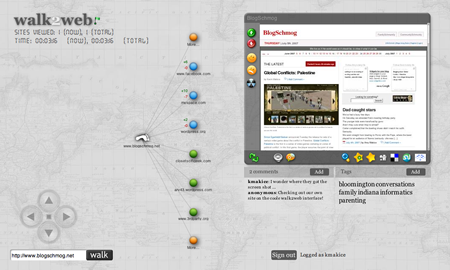As a result of my summer internship, I’ve had to think a lot more about searching the web than I ever have. AltSearchEngines is an excellent blog that covers the search industry, in particular the hundred or so smaller sites trying to break into the top five. This afternoon, ASE posted a truly amazing site that is currently blowing my mind.

Walk2Web is a new way to explore web sites from a specified starting point.
If I could imagine a search tool that combined what I love about complex networks and HCI, this would be pretty close. You type in a starting point—like http://www.blogschmog.net—and you see a page with a screenshot sample of the site and the first two levels of a search network, with sites as nodes. There are no more than six at a time, split between incoming and outgoing links with options to display more in either direction. The network grows as you explore, allowing you to make use of some simple directional tools to navigate the part of the World Wide Web you are manually crawling.
That’s just the core functionality.
The nodes are also color coded to make the network easy to differentiate between incoming links (green) and outgoing (blue). There is a complete community-driven content component that combined digg-like voting with spam prevention, tagging, and comments about the web sites. You can request a refresh of the current screenshot yourself, which means you don’t have to rely on a web crawler to routinely get it for you. You can also flag your own web walking network to allow you to find them again, either as favorites or with little green flag markers to let you see when you encounter a good site again. There is sound (which can be toggled off) that reads as you go. And there are visual cues that show you positive and negative indicators of the community. It is even interesting to just watch the front page—which they call a live sites show—as interesting sites go sliding by.
ASE describes Walk2Web as “pre-alpha,” so there are some implementation issues. The layered parts sometimes visually conflict with each other, especially as the web-walk network starts to grow. Sometimes trying to add a comment results in navigating to a new site, if I’m not careful about where I click. The pop-up information showing screenshots can visually get in the way of some of the navigation controls. I also had great difficulty just trying to get to the help links (although there is a live help feature available from the front page).
Unlike traditional search, where you start with a motivation for searching that relies on some search terms, with Walk2Web you have to know where you want to start. The entire experience and best practices change dramatically as expectations switch to one of discovery and not definitive expertise. This is a tool to find new things in ways you simply cannot with traditional search. It is not likely to be much help if you want to know the tallest mountain in Peru (unless there is a site called http://www.tallestmountaininperu.com).
There is also a browser plug-in (for Firefox and Explorer) that brings the interface to you. So if you wind up on a site that is worthy of a little walk on the Web 2.0 side, simply start the walk from there to bring up the network. The user ratings controls are also in the browser toolbox, so you can rate sites and contribute to them on the fly.
Best thing I’ve seen in a while. I hope it catches on.
1 reply on “Run, don’t walk to Walk, don’t search”
[…] BlogSchmog » Run, don’t walk to Walk, don’t search says: August 6th, 2007 at 3:05 pm […]